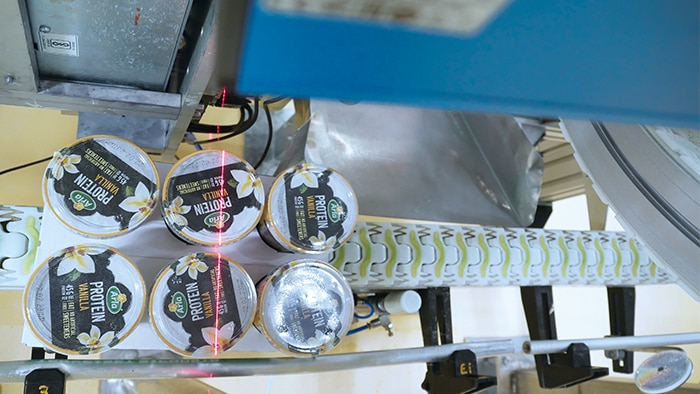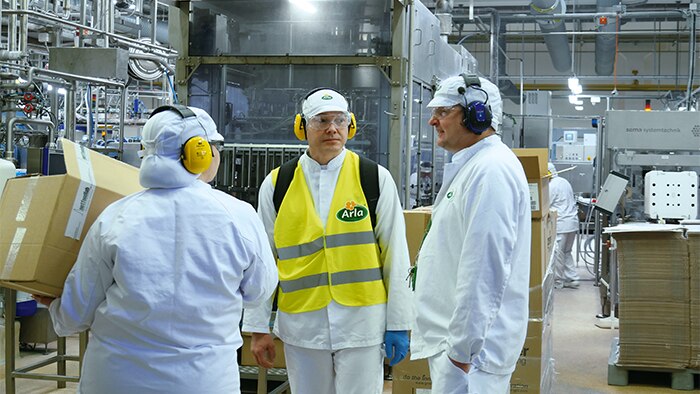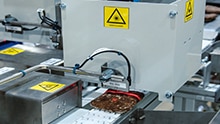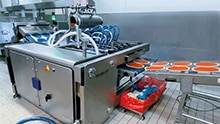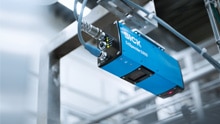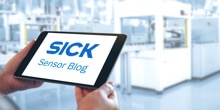In this industry, packaging for transport is one of the most important production steps because only a product supplied intact can generate sustained revenue. In the factory of the dairy company Arla in Sipoo, Finland, the quality control of products is performed using the TriSpector1000 3D vision sensor. A single intelligent sensor is sufficient to ensure the correct packaging of each yogurt container that passes through the packaging line.
The yogurt always in sight: 3D vision solution for packaging in a dairy
Arla produces numerous milk products, including yogurt. The finished end product is packaged in a pot of several deciliters, six of which are placed in each box. The boxes of yogurt are loaded onto a pallet for transport.
The use of plastic in the packaging of yogurt and other products needs to be reduced. That’s why Arla’s factory also switched from plastic boxes to cardboard boxes. The challenge: The adhesive of a cardboard box would sometimes fail on the production line. Occasionally it would happen that one of the six yogurt pots in the box was missing. A ruptured cardboard box will no longer hold the yogurt pots in their place, and an incompletely filled box can no longer support other yogurt boxes. Whole pallets of yogurt can then fall down because a box is damaged or filled incorrectly.
Every box is measured and analyzed

“On the packaging line, the production system has a small blind spot so the operator of the machine cannot see the boxes properly,” says Janne Nickström, the production coordinator at Arla.
A single defective box can already become a problem. It was clear that every packaged box would need to be measured, analyzed, and then accepted or rejected.
Arla turned to PJ Control, a supplier of automation solutions, to jointly search for a suitable technical solution. It turns out that the shape of a correctly loaded, intact yogurt box is consistent and clear, so it was not only possible but also surprisingly easy to measure and analyze its three-dimensional shape. The perfect choice for this task: the TriSpector1000 3D vision sensor.
Productivity gain using just one sensor

A useful feature of the TriSpector1000 is the intelligence integrated into the sensor. The sensor housing also contains an adaptive logic that makes industrial image processing possible. During commissioning, the sensor was taught the correct, acceptable shape of the yogurt box by feeding it images of intact objects. The 3D vision sensor on the production line now tirelessly and repeatedly measures the boxes. The acceptable boxes are allowed to continue on their way to the pallet, the rejected ones are sorted out of the line.
The solution in Arla's factory is also particularly special because a significant improvement in production quality was able to be achieved using only a single sensor and associated equipment. “Thanks to the functioning sensor inspection, we are saving a couple of work hours per week,” calculates Nickström.
Switching between flat and tall boxes – at the press of a button
The software product for controlling the operation of the sensor is the SOPAS Engineering Tool from SICK. It is easy to use, and Arla was also able to independently configure additional functions on the sensor. It is possible, for example, to package two types of yogurt pots on the packaging line, both flat and tall ones. The two types of product boxes can be selected with the press of a button. And if the shape of the yogurt boxes is changed at some time, it is easy to teach the sensor the shape of a new acceptable box. No replacement of the sensor or extensive upgrade project is required.
“The ability to configure the functioning of the sensor ourselves is important to us,” says Nickström. SICK is also satisfied with the end result: “Arla’s project is a fantastic example of how the productivity of an existing production line can be increased through a modest investment in automation. Thanks to the saving of a couple of work hours per week, the investment will pay for itself remarkably quickly,” says Olli Korpinen, area sales manager at SICK in Finland.
Read more
I would like to keep up-to-date and be informed of new articles on a regular basis!
